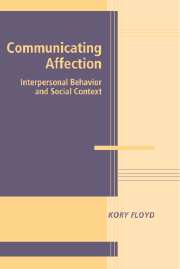Book contents
- Frontmatter
- Contents
- List of Tables
- List of Figures
- Foreword
- 1 AN INTRODUCTION TO AFFECTIONATE COMMUNICATION
- 2 THINKING ABOUT AFFECTION: THE THEORIES
- 3 ENCODING AFFECTIONATE MESSAGES
- 4 DECODING AND RESPONDING TO AFFECTIONATE EXPRESSIONS
- 5 BENEFITS OF EXPRESSING AND RECEIVING AFFECTION
- 6 RISKS ASSOCIATED WITH AFFECTIONATE COMMUNICATION
- 7 A NEW THEORETIC APPROACH
- 8 AFFECTIONATE COMMUNICATION IN HUMAN INTERACTION
- References
- Index
4 - DECODING AND RESPONDING TO AFFECTIONATE EXPRESSIONS
Published online by Cambridge University Press: 02 December 2009
- Frontmatter
- Contents
- List of Tables
- List of Figures
- Foreword
- 1 AN INTRODUCTION TO AFFECTIONATE COMMUNICATION
- 2 THINKING ABOUT AFFECTION: THE THEORIES
- 3 ENCODING AFFECTIONATE MESSAGES
- 4 DECODING AND RESPONDING TO AFFECTIONATE EXPRESSIONS
- 5 BENEFITS OF EXPRESSING AND RECEIVING AFFECTION
- 6 RISKS ASSOCIATED WITH AFFECTIONATE COMMUNICATION
- 7 A NEW THEORETIC APPROACH
- 8 AFFECTIONATE COMMUNICATION IN HUMAN INTERACTION
- References
- Index
Summary
We may not return the affection from those who like us, but we always respect their good judgment.
– Libbie FudimThe focus in the previous chapter was on the formulation of affectionate messages from the point of view of the sender. However, expressions of affection are provocative events for receivers as well. When individuals are the recipients of affectionate behaviors they are typically called on to make at least two assessments: first, are they correctly decoding these behaviors as affectionate messages, and second, how should they respond to them? This chapter will review research that has addressed each of these issues and will articulate new questions in this area that await empirical attention.
Decoding Behaviors as Affectionate
Competence in telling friend from foe is perhaps one of the most useful human abilities in terms of individual and group survival. Affectionate communication most assuredly plays a part in forming and maintaining pair bonds and other significant relationships, but only to the extent that one's affectionate overtures are decoded as such by recipients. As will be illustrated in Chapter 6, incongruence between a sender's intention with an affectionate message and a receiver's interpretation of that message is one of the major sources of risk in communicating affection in the first place. For these reasons, this section will discuss research on the decoding of affectionate behaviors.
- Type
- Chapter
- Information
- Communicating AffectionInterpersonal Behavior and Social Context, pp. 51 - 86Publisher: Cambridge University PressPrint publication year: 2006



